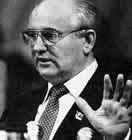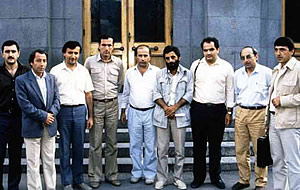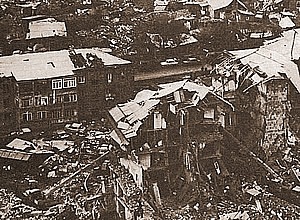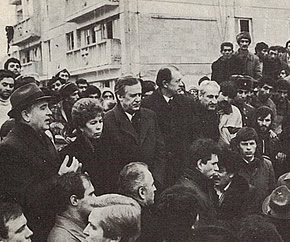MIATSUM!
Armenians support Perestroika
 Mikhail Gorbachev
Mikhail Gorbachev
In 1985-1986, the new Soviet leader Mikhail Gorbachev launched a campaign aimed at reforming the Soviet Empire. The Armenians were almost unanimous in their enthusiastic support of perestroika and glastnost.
In late 1987, the Armenians of Nagorno-Karabakh collected over 80,000 signatures to petition the Soviet Government about the secession of the region from the Soviet Azerbaijan, and its reunification (Miatsum, in Armenian) to Armenia. After suffering for decades under the Azeri tyranny, the people of Karabakh thought the time was favorable to restore the historical truth.
At the same time, an unprecedented movement of support began in Armenia. Mass meetings, manifestations and general strikes frightened the Soviet leaders. These actions, both in Karabakh and Armenia were peaceful and well organized. As a matter of fact, the Gorbachev’s perestroika experienced its first serious trial. To the great disappointment of the Armenians, the Kremlin will first take a ‘wait-and-see’ attitude, only to support Azerbaijan by declaring that “the map of the USSR will never be redrawn”.
Azeri atrocities in Sumgait
In February 26-28, Azerbaijan took measures in a classic Ottoman fashion. Mass pogroms occurred in a small city of Sumgait, near Baku. Hundreds of innocent Armenians, including old people, women and children, were attacked in their homes by Azeri fanatic mobs to be beaten, raped, killed and burned alive. For the period of 3 days the city was plunged into complete anarchy. The deadly riots were designed and led by the members of the local government in Sumgait. The apartments of Armenians were ransacked or destroyed.
The Karabakh Committee
The rallies and peaceful protest actions in Armenia were organized by a group of intellectuals who formed the Karabakh Committee. The movement initially aimed at protecting the constitutional rights of Armenians in Artsakh gradually transformed into the All-Armenian national liberation movement. The leaders of the Karabakh Committee rapidly gained general support and admiration. By the fall of 1988, the Karabakh Committee became a powerful political force in Armenia.
Pogroms in Kirovabad
In late November, as tensions increased and the danger of the new pogroms threatened the Armenians in Azerbaijan, a new wave of meetings and strikes began in Armenia. A large number of Armenian refugees fled Azerbaijan and arrived in Armenia.
In Kirovabad, the second large city of Azerbaijan, barbaric atrocities were committed. The armed Azeri bandits broke into a retirement house and killed a dozen of aged Armenians.
In response to these actions, following the common practice of a “parity rule”, the Soviet Government imposed marshal law in both unruly Azerbaijan and relatively peaceful Armenia.
December 7, 1988
 Rescue works in Leninakan (present day Guymri) in December 1988
Rescue works in Leninakan (present day Guymri) in December 1988
On December 7, 1988, the Armenian history turned a new tragic page. A devastating earthquake wiped off the northern regions of the Republic, killing at least 25 thousand and making 500 thousand homeless. An unprecedented campaign of direct aid to Armenia (not via Moscow) began in many countries, symbolizing the near end of the Iron Curtain.
Against the backdrop of a general mourning, Moscow tried to put an end to the Karabakh movement. The leaders of the Karabakh Committee were arrested and taken to Moscow. However, they were released from prisons 6 months later and returned in triumph to Armenia to found the Armenian Pan-National Movement. In summer of 1989, the 4 APNM representatives were elected members of the Armenian parliament.
The Azeri blockade of Armenia and Karabakh
From the early 1989, Azerbaijan imposed a severe economic blockade of Armenia and Artsakh. That resulted in the dramatic shortages of gas and other energy sources. At the same time, the Metsamor plant, the only nuclear station in Transcaucasia was shut down in Armenia, which severely diminished energy supply. Food supplies also greatly diminished.
Meanwhile, the situation extremely aggravated in Artsakh. In November of 1989, the USSR Supreme Soviet abolished the Special Administration Committee of Nagorno-Karabakh which was decreed earlier to subordinate the region directly to Moscow. Instead, the Organizational Committee of Nagorno-Karabakh was formed to reinstate the jurisdiction of Azerbaijan.
On December 1, 1989 the Armenians of Armenia and Nagorno-Karabakh responded with a mutual decision of their parliaments, proclaiming the reunification of Armenia and Artsakh. That provoked mass disturbances and unrest in Azerbaijan.










